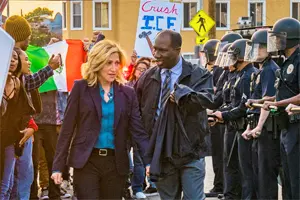TV portrays protesters as faceless rabble while police are bestowed with humanity
-

Portrayals of protesters in scripted shows play a big role in viewers dismissing real-life demonstrations as chaotic and violent, says Melanie McFarland. That's why peaceful protesters are often seen in a negative light, indistinguishable from rioters and looters, even when it's the police who are rioting. McFarland points to Edie Falco's recently canceled CBS freshman drama Tommy, which kicks off with her hard-nosed chief of police character calmly and authoritatively asserting herself amid protesters "who are basically the human version of a house fire into which Falco's character can bravely charge." Shows like Westworld and Mr. Robot have also portrayed protesters as threats. "Contrast this to how recent days have filled our screens and our eyes with visions of armored and armed police officers spraying protesters with rubber bullets, running into them with vehicles, flinging them to the pavement like rag dolls or yanking them from cars as they taser them into submission," says McFarland. "The world witnesses this alongside buildings burning, corporate logos vandalized, and faceless looters of indeterminate identity breaking into chain boutiques and big box stores and helping themselves to merchandise. Predictably in uninformed conversations about these acts of civil disobedience disrupting life, it is the protesters and the movements associated with them that take some reflexive blame for any destruction that accompanies their demonstrations. It doesn't take a SpaceX engineer to come up with reasons as to why that is, besides years upon years of quick-hit, slapdash TV news coverage of protests and the movements that inspired them. But a portion of blame rests in how protests and protesters are portrayed within scripted series, be they comedies or procedurals. If the audience can't define a peaceful act of civil disobedience turned violent by outside agitators from a mindless riot, that may be due to the fact that our primetime dramas and the odd half-hour comedy fails to find much of a distinction between one and another. On prime time, TV demonstrations are unruly obstacles for heroes to exploit to their own ends or navigate in order to discover their main mission. They're dangerous distractions from workaday normalcy or an excuse for aimless kids to break glass or deface property."
ALSO:
- How TV news skews the way protests are perceived: "Like so many Americans, I’ve been glued to screens over the past few weeks, sometimes watching Twitter or Instagram video from the demonstrations on my phone as I watch news channels cover the same scenes from a different angle on TV," says Judy Berman. "By now, most of us have some awareness of what differentiates the major networks’ sober, painstakingly evenhanded broadcasts, the liberal spin of MSNBC, the conservative slant of Fox News and the barrage of graphics, experts and takes that is CNN. It’s no surprise that just about every evening news anchor has toggled between just-the-facts accounts of the protests; reports of police brutality toward demonstrators; hand-wringing about looters; items expressing concern about public gatherings in light of the pandemic; and human-interest stories where black people and men in blue hug, listen to each other, march hand in hand. Nor would I expect any eyebrows raised at Fox News hosts holding forth, on Wednesday, under the headline 'Attacks Against Law Enforcement Amid Nationwide Riots' while CNN announced 'Large Protests in D.C. as Curfew Pushed Back Tonight' and the MSNBC chyron read: 'Peaceful Protests Tonight in Cities Across the U.S.' We know that each outlet frames—if not, consciously or otherwise, selects—stories to fit either their respective in-house slant or a desire to appear neutral. What we talk less about is the visuals that accompany those stories—which, in the case of protest footage, is often juxtaposed with the voices of hosts or guest pundits who may or may not be discussing the specific images we see onscreen. That, too, is carefully selected. You can tell because it differs so widely from channel to channel."
- Twitter and other social media have exposed local TV news' blindspots in covering protests: "In the early going, local press, including this paper, often seemed to pay more attention to violent instigators and looters than to the overwhelming majority of peaceful protesters," says the Los Angeles Times' Lorraine Ali. "TV reporters embedded behind police lines more than they embedded with activists. Cops were shown as protectors while demonstrators of color were portrayed as the problem. Coverage was dominated by the uprising’s most outrageous moments. Commentary was often from the white perspective and aimed at easing the fear of white folks. The pressure and outrage of a nation, however, is shifting those dynamics, which evolved on screen over the week. Reporters who used the terms 'protesters' and 'looters' interchangeably had been called out so vigorously that by the time a state of emergency was called in Los Angeles, reporters were making concerted efforts to differentiate between marchers and 'smash-and-grab crews.' Clips of police using excessive force against demonstrators, and also marching next to them, have been pushed to the fore. Chyrons now use terms like 'peace marches' rather than 'violent protests' below footage of large crowds."
- How different do the George Floyd protests look on Twitter vs. cable news?
- The graphic viral video of Buffalo police shoving a 75-year-old protester to the ground was censored on some local Buffalo TV news stations to avoid showing him bleeding
TOPICS: Tommy, CNN, Fox News Channel, MSNBC, Mr. Robot, Westworld, George Floyd, Black Lives Matter, Cable News, Journalism
